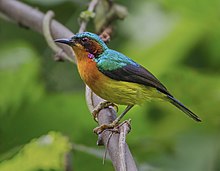Ruby-cheeked sunbird
| Ruby-cheeked sunbird | |
|---|---|

| |
| Male | |

| |
| Female | |
| Scientific classification | |
| Domain: | Eukaryota |
| Kingdom: | Animalia |
| Phylum: | Chordata |
| Class: | Aves |
| Order: | Passeriformes |
| Family: | Nectariniidae |
| Genus: | Chalcoparia Cabanis, 1851 |
| Species: | C. singalensis |
| Binomial name | |
| Chalcoparia singalensis (Gmelin, JF, 1789) | |
The ruby-cheeked sunbird (Chalcoparia singalensis) is a species of sunbird in the family Nectariniidae.
Taxonomy
The ruby-cheeked sunbird was formally described in 1789 by the German naturalist Johann Friedrich Gmelin in his revised and expanded edition of Carl Linnaeus's Systema Naturae. He placed it with the wagtails in the genus Motacilla and coined the binomial name Motacilla singalensis.[2] Gmelin erroneously specified the type locality as Ceylon (now Sri Lanka) where the species does not occur. The locality was designated as Malacca on the Malay Peninsula by the American ornithologist Harry C. Oberholser in 1912.[3][4] Gmelin based his account on the "green warbler" from the East Indies that had been described and illustrated in 1776 by the English naturalist Peter Brown.[5] The ruby-cheeked sunbird is now the only species placed in the genus Chalcoparia that was introduced in 1850 by the German ornithologist Jean Cabanis.[6][7] The genus name is from Ancient Greek khalkoparēos meaning "with cheeks of bronze". The specific epithet is from the erroneous type locality, Sri Lanka.[8]
Eleven subspecies are recognised:[7]
- C. s. assamensis Kloss, 1930 – east Himalayas and Bangladesh to south China, north Thailand and north Myanmar
- C. s. koratensis Kloss, 1918 – east Thailand and Indochina
- C. s. internota (Deignan, 1955) – south Myanmar to north Malay Peninsula
- C. s. interposita Robinson & Kloss, 1921 – central Malay Peninsula
- C. s. singalensis (Gmelin, JF, 1789) – south Malay Peninsula
- C. s. sumatrana Kloss, 1921 – Sumatra, Lingga Islands and Belitung (east of Sumatra)
- C. s. panopsia Oberholser, 1912 – islands west of Sumatra
- C. s. pallida Chasen, 1935 – Natuna Islands (northwest of Borneo)
- C. s. borneana Kloss, 1921 – Borneo
- C. s. bantenensis (Hoogerwerf, 1967) – west Java
- C. s. phoenicotis (Temminck, 1822) – central, east Java
Distribution and habitat
It is found in Bangladesh, Bhutan, Brunei, Cambodia, China, India, Indonesia, Laos, Malaysia, Myanmar, Nepal, Thailand, and Vietnam. Its natural habitats are subtropical or tropical moist lowland forest, subtropical or tropical mangrove forest, and subtropical or tropical moist montane forest.[1]
References
- ^ a b BirdLife International (2016). "Chalcoparia singalensis". IUCN Red List of Threatened Species. 2016: e.T22717626A94542835. doi:10.2305/IUCN.UK.2016-3.RLTS.T22717626A94542835.en. Retrieved 15 November 2021.
- ^ Gmelin, Johann Friedrich (1789). Systema naturae per regna tria naturae : secundum classes, ordines, genera, species, cum characteribus, differentiis, synonymis, locis (in Latin). Vol. 1, Part 2 (13th ed.). Lipsiae [Leipzig]: Georg. Emanuel. Beer. p. 964.
- ^ Oberholser, Harry C. (1912). "Descriptions of one hundred and four new species and subspecies of birds from the Barussan Islands and Sumatra". Smithsonian Miscellaneous Collections. 60 (7): 1-22 [21].
- ^ Paynter, Raymond A. Jr, ed. (1986). Check-List of Birds of the World. Vol. 12. Cambridge, Massachusetts: Museum of Comparative Zoology. p. 215.
- ^ Brown, Peter (1776). Nouvelles illustrations de zoologie : contenant cinquante planches enlumineés d'oiseaux curieux, et qui non etés jamais descrits, et quelques de quadrupedes, de reptiles et d'insectes, avec de courtes descriptions systematiques [New illustrations of zoology, containing fifty coloured plates of new, curious, and non-descript birds, with a few quadrupeds, reptiles and insects]. London: Imprimé pour B. White. p. 82, Plate 32 Fig. 2.
- ^ Cabanis, Jean (1850–1851). Museum Heineanum : Verzeichniss der ornithologischen Sammlung des Oberamtmann Ferdinand Heine, auf Gut St. Burchard vor Halberstadt (in German and Latin). Vol. 1. Halberstadt: R. Frantz. p. 103.
- ^ a b Gill, Frank; Donsker, David; Rasmussen, Pamela, eds. (July 2023). "Dippers, leafbirds, flowerpeckers, sunbirds". IOC World Bird List Version 13.2. International Ornithologists' Union. Retrieved 19 August 2023.
- ^ Jobling, James A. (2010). The Helm Dictionary of Scientific Bird Names. London: Christopher Helm. pp. 98, 357. ISBN 978-1-4081-2501-4.

